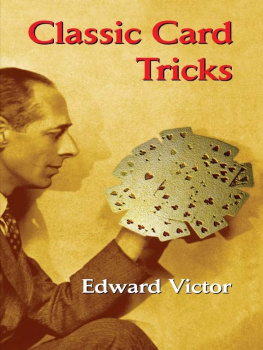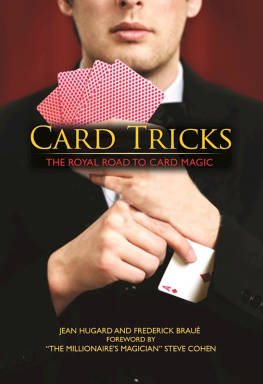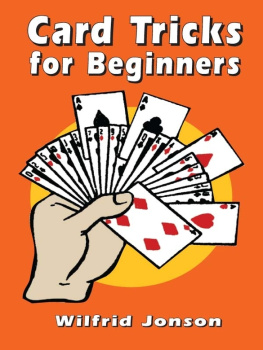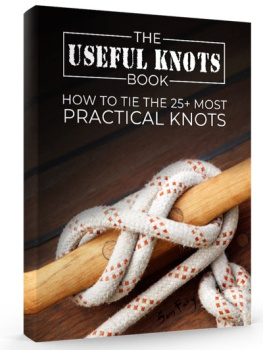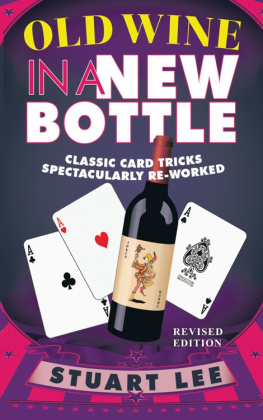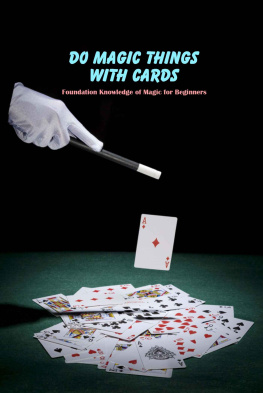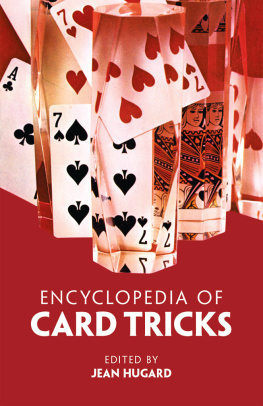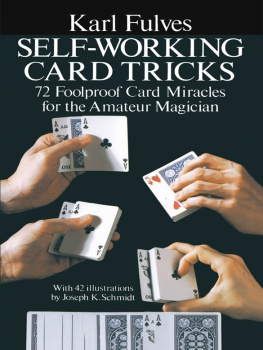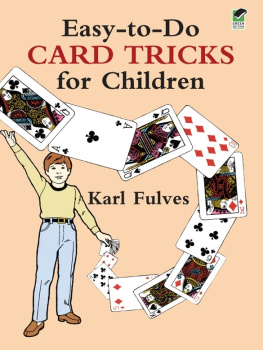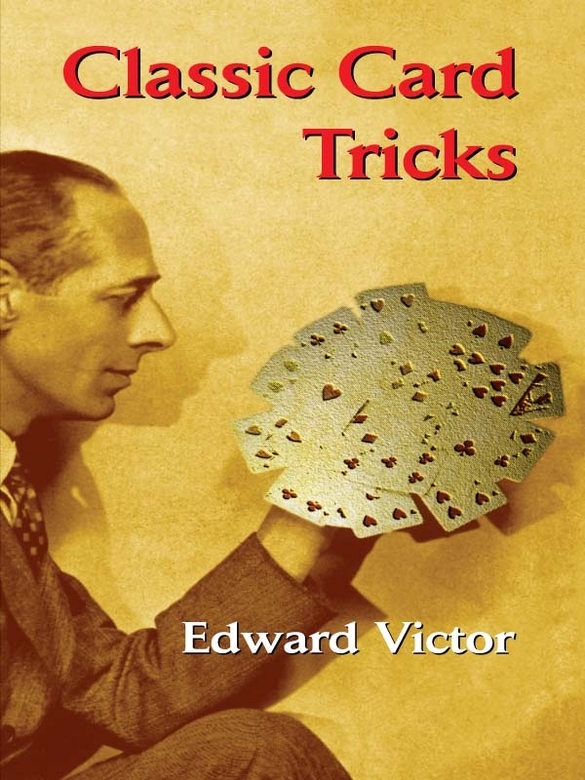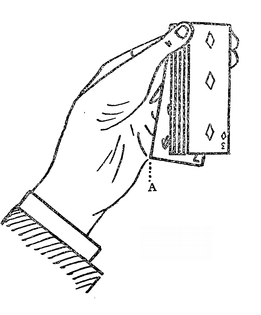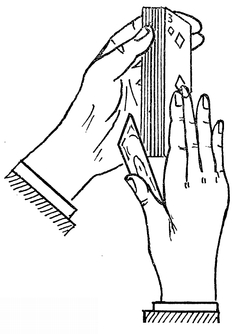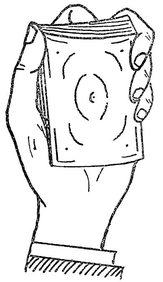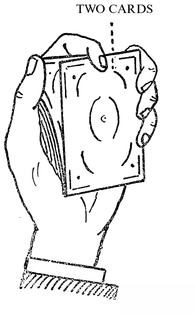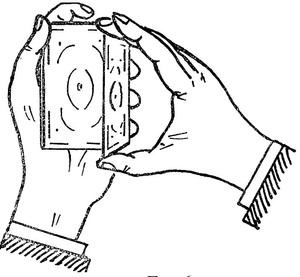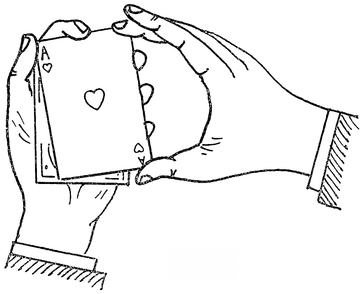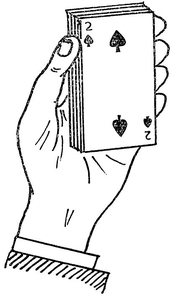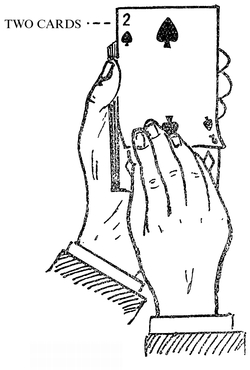1. Some Useful Card Sleights I Have Proved Effective.
The Pass.
Naturally, in a work of this description, it is only right that I should commence the card section with The Pass, and I therefore introduce a method of executing this well-known and indispensable sleight.
The methods already published in books and magazines of making the pass invisibly are legion.
The cover I always make use of is a riffle of the lower half of the pack immediately this portion has been brought to the top after the pass is made.
This is accomplished as follows:
The selected card is returned to the pack and the little finger of the left hand is inserted above it in the usual manner for making the double-handed pass as the cards are squared up.
Holding the pack in the left hand (with the little finger inserted above the selected card), first give the pack a riffle at the top end with the fingers of the right hand, the right thumb being at the lower end of the pack.
Then immediately make the ordinary double-handed pass, and as the lower half of the pack comes to the top bend it outwards with the right fingers and riffle it down on to the top of the pack.
The effect created will be that you have once more merely lifted the top half of the pack and riffled it back again.
The required card is now on the top of the pack.
The E.V. Colour Change.
This is an invisible removal of a card from the back of the pack. The sleight is accomplished as follows:
Hold the pack in the left hand face outwards, the top of the thumb across one side at the top, and the first and second fingers at the top side opposite. The bottom of the pack is held well away from the palm. ( See .)
The palm of the right hand is shown empty and, approaching the pack, covers the face card with the fingers apart.
Under cover of this hand the third fingertip of the left hand separates the bottom card of the pack and pushes it towards the left thumb, as shown in , where it is immediately gripped by the fork of the right thumb at its lower projecting corner at A in the figure.
As the card is gripped by the right thumb, the first and second fingers of that hand are closed up, only the third and little fingers being held apart. The right hand slowly moves down the face of the pack, carrying with it the card held at the fork of the thumb. (.)
When this card is clear of the bottom of the pack, the right hand once more rubs the face card, making the desired change.
The E.V. Invisible Double Lift.
Many of the present-day card tricks depend upon the principle of holding and showing two or more cards as one only.
I therefore give you my method of apparently lifting one card only from the top of the pack, but in reality taking two or more.
This particular sleight I consider well worth the practice necessary to acquire it, and, once mastered, it will be found extremely useful on many occasions. It is necessary for the performer to get the initial hold of the cards correctly.
The pack is held in the left hand face downwards, with the thumb lying along the side, the top being at the top left-hand corner. The second, third and little fingers are at the opposite side.
The first finger is curled behind the pack, the nail pressing against the face of the bottom card, near the top.
The bottom left-hand corner of the pack is touching the ball of the left thumb.
Holding the pack thus, well squared up, bend the cards outwards by pressing on them from behind with the nail of the first finger and slightly contracting the thumb and fingers at either side. (.)
Hence the reason for holding the first finger curled behind the pack at the commencement.
Having bent the pack as explained (only a slight bend is necessary), move the left first finger to a position at the top of the pack and near the tip of the left thumb. Thus thumb now releases or runs the two top cards. (.)
The tip of the left first finger being held slightly curled over the top end of the pack prevents any movement of the two top cards being seen as they are released by the thumb.
The right hand now approaches the pack and lifts the two released cards, holding them together, as one card, at their extreme left hand top and bottom corners between the tips of the thumb and second fingers.
The right side of these two cards remains against the second, third and little fingers of the left hand as the cards are turned face upwards. (.)
The corners of these two cards as they turn pivot round the tips of the thumb and second finger of the right hand, which then places them face upwards on the top of the pack.
The second, third and little fingers of the left hand then level them up against the left thumb, the right thumb and second finger keeping their hold on the corners of the two cards all the time. (.)
Having shown the top card, and with the right hand still holding the corners as illustrated in , the same move is now reversed, the two cards being lifted and turned again face downwards on to the top of the pack.
A New Glide.
Presuming a card has been freely selected and returned to the pack, and that the performer desires to apparently cause the bottom card of the pack to change into the chosen card, the Glide or Slip is made use of, which consists in showing and removing the bottom card of the pack, but in reality taking away the card above it.
In the following sleight the bottom card is apparently in view the whole time. The pack is held in the left hand, face outwards, the tip of the thumb on one side and the first joints of the fingers at the other, as illustrated in .

